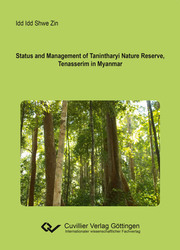| Departments | |
|---|---|
| Book Series (96) |
1378
|
| Nachhaltigkeit |
3
|
| Gesundheitswesen |
1
|
| Humanities |
2365
|
| Natural Sciences |
5406
|
| Mathematics | 229 |
| Informatics | 319 |
| Physics | 980 |
| Chemistry | 1363 |
| Geosciences | 131 |
| Human medicine | 243 |
| Stomatology | 10 |
| Veterinary medicine | 108 |
| Pharmacy | 147 |
| Biology | 835 |
| Biochemistry, molecular biology, gene technology | 121 |
| Biophysics | 25 |
| Domestic and nutritional science | 45 |
| Agricultural science | 1004 |
| Forest science | 201 |
| Horticultural science | 20 |
| Environmental research, ecology and landscape conservation | 148 |
| Engineering |
1793
|
| Common |
98
|
|
Leitlinien Unfallchirurgie
5. Auflage bestellen |
|
Advanced Search
Status and Management of Tanintharyi Nature Reserve, Tenasserim in Myanmar (English shop)
Idd Idd Shwe Zin (Author)Preview
Table of Contents, PDF (140 KB)
Extract, PDF (180 KB)
In Myanmar, 16% of the total forest area is made up of rich evergreen forests which mostly occur in the northern and southern parts of the country. Tanintharyi Nature Reserve (TNR) is located in Southern Myanmar, an area under severe threat of rubber and palm oil plantations, ineffective land use shifting cultivation, encroachment into forests, and indiscriminate cutting leading to deforestation. Firstly, this study was carried out in TNR as an ecosystem analysis. In the core zone, 81 species in the primary moist evergreen forest-1 and 57 species in the degraded moist forest-1 were identified. In the buffer zone, 83 species in the primary moist evergreen forest-2; 86 species in the secondary moist evergreen forest-2, and 67 species in the degraded moist deciduous forest-2 were enlisted. For species-site matching and their performance, Michelia champaca, Aglaia andamanica, Ficus glomerata, Pterocarpus macrocarpus, Lithocarpus sp-1, and Cinnamonum pachphyllum in the highland areas and Vitex peduncularis, Oroxylum indicum, and Barringtonia cymosa in the degraded lowland areas were therefore the most adaptable species to environmental and salt stresses for reforestation in TNR. This study in the greenhouse found that the soil solute potentials of Xylia xylocarpa seedlings for the commercial potting soil and hydroponic gravel culture were -1.5 MPa and -1.2 MPa respectively for their tolerance to soil salinity to the reforestation programme in the TNR degraded land areas. The nitrogen content (% MS) of the important 35 tree species showed very weak relationship with their diameter distribution or slope b values in this study for light requirements. Moreover, top height could be used to classify species into groups for light requirements in this study. The minimum midday and saturated osmotic potentials could also be used to assess salt concentration in the root zone in order to select species for the reforestation program in the TNR degraded land areas.
| ISBN-13 (Hard Copy) | 9783736995093 |
| ISBN-13 (eBook) | 9783736985094 |
| Final Book Format | A5 |
| Language | English |
| Page Number | 292 |
| Edition | 1. Aufl. |
| Publication Place | Göttingen |
| Place of Dissertation | Göttingen |
| Publication Date | 2017-04-10 |
| General Categorization | Dissertation |
| Departments |
Forest science
|
| Keywords | reforestation, commercial potting soil, hydroponic gravel culture, nitrogen content (% MS), top height, midday osmotic potential and saturated osmotic potential |








